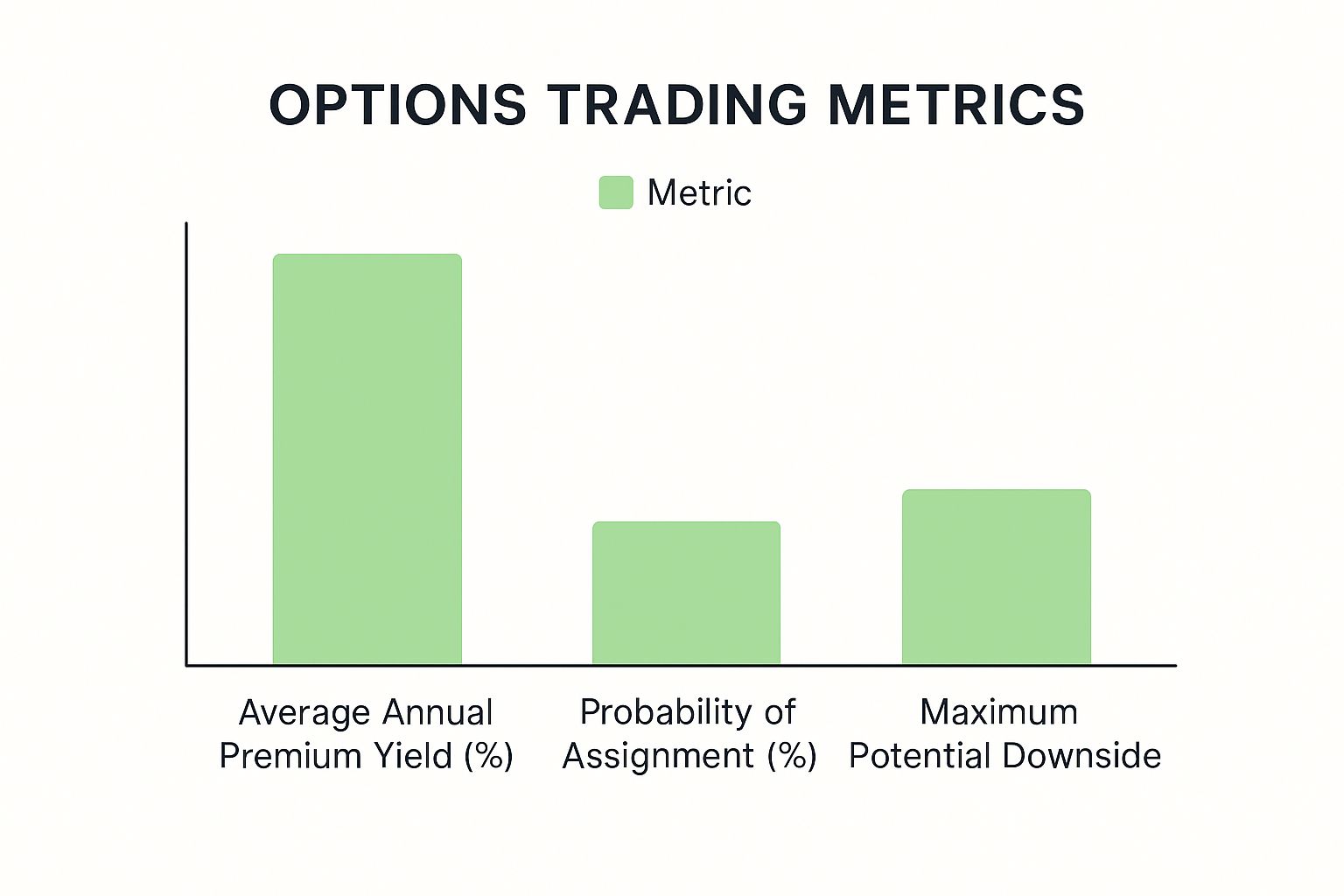Covered Call Strategy: Real Results & What Works
If a stock moves past your strike, the option can be assigned — meaning you'll have to sell (in a call) or buy (in a put). Knowing the assignment probability ahead of time is key to managing risk.
Posted by
Related reading
A Definitive Guide to Short Call Options Strategies
Master short call options, from covered calls to naked calls. Learn proven strategies to manage risk, generate income, and analyze payoffs like a pro.
What Is a Strangle An Options Trading Guide
Uncover what is a strangle in options trading. This guide explains how to use this powerful volatility strategy for both big market moves and stability.
Credit Spread Vs Debit Spread A Trader's Decisive Guide
Dive into the credit spread vs debit spread debate. Learn which options strategy fits your goals with real-world scenarios and risk-reward analysis.
Understanding What Covered Calls Actually Do
A covered call strategy involves selling call options on shares of stock you already own. This gives someone else the right, but not the obligation, to buy your shares at a pre-set price (the strike price) before a specific date (the expiration date). In return, you receive a premium. But how does this impact your portfolio?
How Premium Collection Works
Think of the premium you receive as rent on your shares. For instance, if you own 100 shares of XYZ stock and sell one call option contract (representing 100 shares) with a $1 premium per share, you'll receive $100 upfront. This $100 is yours to keep, whether or not the option is exercised. This income generation is the main attraction of covered calls. The premium also provides a small buffer against potential losses if the stock price drops.
The Importance of Strike Price Selection
Your chosen strike price significantly affects your potential profit and the likelihood of your shares being called away. A lower strike price generates higher premiums because there's a greater chance the option buyer will profit. However, it also increases the risk of your shares being called away if the stock price climbs above the strike price.
A higher strike price, on the other hand, produces lower premiums but gives you more upside potential before your shares are called away. Strike price selection involves balancing income against potential share appreciation.
Expiration Timing and Its Impact
The expiration date you choose is also important. Shorter-term expirations, like weekly or monthly options, typically offer smaller premiums per contract but provide more frequent opportunities to generate income. Longer-term expirations, like LEAPS (Long-Term Equity Anticipation Securities), offer larger upfront premiums, but fewer chances for repeated premium collection. Understanding these dynamics is vital for timing your entries and exits.
The Income-Upside Trade-Off
The core of the covered call strategy is the trade-off between income and potential upside. Selling calls effectively limits your potential gains if the stock price surpasses the strike price plus the premium received. If your stock price increases substantially, you'll miss out on the gains above your strike price.
However, if the stock price remains flat or declines, you keep the premium, which can potentially offset losses. The right covered call strategy depends on your investment goals and risk tolerance. Grasping this fundamental trade-off is essential for maximizing returns and minimizing potential downsides.
What The Performance Data Really Tells Us

While covered calls can generate income, a closer look at the performance data reveals some important points to consider. It's essential to understand both the potential upsides and the potential downsides before using this strategy. Let's explore the numbers.
Long-Term Returns and Risk-Adjusted Performance
Many investors are attracted to covered calls because of their potential to boost returns. However, long-term studies often tell a different story. A study analyzing S&P 500 Index covered call strategies from January 1999 to June 2023 found that, on average, selling S&P 500 index call options didn't produce positive returns compared to simply holding the index.
Research by Israelov and Ndong (2023) revealed that selling a call option often led to losses, with the average outcome being negative. More detailed statistics can be found here: https://alphaarchitect.com/covered-calls/
Furthermore, when considering risk-adjusted performance, covered calls don't always beat a basic buy-and-hold strategy. The limited upside potential prevents the strategy from fully benefiting from market rallies.
Covered Calls in Bull and Bear Markets
Analyzing how covered calls perform in different market conditions is vital. During strong bull markets, covered calls often underperform. The premiums collected are usually smaller than the potential gains from holding the underlying stock. This can mean missed opportunities for investors.
In bear markets, the premiums can provide some downside protection. However, it's important to understand that this protection is generally limited.
The Downside of Capped Upside Potential
A primary drawback of covered calls is the capped upside potential. When the stock price exceeds the strike price, your profits are limited to the premium collected plus the difference between the strike price and your initial purchase price. In a rapidly rising market, this limits the potential for large gains. You can learn more in this article about Covered Calls & Strike Price.
Understanding Realistic Expectations
The key takeaway from the performance data is to have realistic expectations. Covered calls are not a guaranteed way to maximize returns in all market situations. They can be a helpful strategy in certain circumstances, especially in sideways or slightly declining markets. However, they shouldn't be seen as a surefire path to wealth.
By understanding how covered calls truly perform, investors can make better decisions about whether this strategy fits their investment goals and risk tolerance. Recognizing the limitations and potential drawbacks is critical for successful implementation and avoiding disappointment. Careful consideration of market conditions, strike price selection, and expiration timing are all important for maximizing potential benefits and minimizing the inherent risks.
When Covered Calls Work (And When They Don't)

The infographic above illustrates the interplay between the average annual premium yield, the probability of assignment, and the potential downside of a covered call strategy. Notice how higher potential premium yields often correlate with a greater chance of assignment and increased downside risk. This underscores the need to understand market conditions and their impact on covered call effectiveness.
Market Scenarios for Covered Call Success
Covered calls often shine in sideways or neutral markets. Price fluctuations are minimal in these conditions, letting you consistently collect premiums without the constant worry of your shares being called away. This steady income can boost overall returns, particularly when price appreciation is limited.
Imagine owning a stock trading around $50 and selling a covered call with a $52 strike price. If the market remains sideways, the stock price is likely to stay below $52. This allows you to keep both the premium and your shares.
When Covered Calls Fall Short
Conversely, covered calls can underperform a simple buy-and-hold strategy in bull markets. Your profit is capped at the strike price, preventing you from fully benefiting from significant price increases. You're essentially exchanging potential upside for the relative certainty of premium income.
During rapid price appreciation, the premiums collected may be dwarfed by the potential profits from simply holding the underlying stock. Should you expect more from your covered call strategy? Consider this: traditional monthly covered call strategies over the past decade, as represented by the CBOE S&P 500 BuyWrite Index, delivered just 61% of the S&P 500's returns in up markets and 84% in down markets, measured quarterly.
The Impact of Volatility
Volatility is another key factor in covered call success. High volatility increases option value, leading to higher premiums. This can be tempting for income generation, but it also raises the probability of assignment. Low volatility, on the other hand, produces smaller premiums but reduces the likelihood of your shares being called away.
The following table illustrates the performance differences between a buy-and-hold strategy and a covered call strategy across various market conditions.
Covered Call Performance Comparison Across Market Conditions
Market Condition | S&P 500 Return | Covered Call Return | Relative Performance |
|---|---|---|---|
Bull Market | 20% | 12.2% | Underperforms by 7.8% |
Bear Market | -10% | -8.4% | Outperforms by 1.6% |
Sideways Market | 2% | 5% | Outperforms by 3% |
This table demonstrates how covered calls can provide downside protection in bear markets and enhanced returns in sideways markets, while lagging in bull markets.
Choosing the Right Environment
A successful covered call strategy requires a nuanced understanding of market conditions. Look for stocks expected to stay within a specific price range or experience moderate growth. Also, consider your own risk tolerance and income goals.
If income generation is your primary objective and you’re comfortable with limited upside, covered calls can be a valuable tool, especially during periods of low or moderate volatility and sideways price action. However, if maximizing capital appreciation is your goal, a buy-and-hold approach may be more suitable during bull markets. Tools like Strike Price can help you make informed decisions by offering real-time probability metrics and alerts for each strike price.
The Truth About Risk Management and Protection

Covered calls are often touted as a conservative strategy for generating income. However, it's essential to recognize that they still involve risks. Understanding the actual level of downside protection offered by covered calls, and when this protection is most effective, is crucial. This requires looking beyond the hype and delving into the practical realities of this strategy.
How Much Protection Do Covered Calls Really Offer?
The premium you receive from selling a covered call provides a cushion against potential losses. If the stock price declines, this premium helps offset the drop.
For example, if you earn a $1 premium per share and the stock price falls by $0.50, your net loss is only $0.50 per share.
However, this protection is limited to the premium amount. If the stock price experiences a significant drop, the premium received might not be enough to offset the losses.
Covered Calls During Market Crashes
Analyzing historical market crashes can illuminate how covered calls perform during significant downturns. A study of covered call returns between 1986 and 1989 provides a valuable illustration.
The research revealed that covered call portfolios generally underperformed the underlying stocks, with the exception of 1987. During that year, which included a substantial market crash, both strategies had similar returns, likely due to the limited downside experienced by the covered call positions. Learn more about this period of market volatility here: Market Volatility 1986-1989
This highlights an important point about covered calls: they provide some downside protection, but it’s not absolute. In a severe market crash, losses can still be significant, even with the collected premium. Furthermore, the capped upside potential of covered calls can hinder your ability to participate in market rebounds after a crash.
Balancing Income and Capital Preservation
Effectively using covered calls involves understanding the balance between generating income and preserving capital. The premium income offers a buffer, but it comes at the price of limiting potential upside gains. You might be interested in: How to Master Covered Calls.
Different approaches to covered calls, like adjusting the strike price and expiration dates, will affect your overall risk exposure.
Out-of-the-money calls: Generate less income but provide greater upside potential if the stock price increases.
In-the-money calls: Produce higher premiums but elevate the risk of your shares being called away and limit upside potential.
Understanding Your Risk Tolerance
Before implementing a covered call strategy, assessing your risk tolerance is vital. Consider these questions:
How much potential downside are you comfortable with?
What are your income goals?
These questions help determine the right approach.
For instance, a lower risk tolerance might lead you to choose higher strike prices to protect potential gains while accepting lower premium income. Conversely, a higher risk tolerance might encourage you to select lower strike prices to maximize income potential while accepting a greater risk of assignment.
Smart Strike Selection And Timing Decisions

A successful covered call strategy hinges on smart decisions. These key decisions revolve around strike prices, expiration dates, and market timing. This section will guide you through proven methods for selecting the best strikes. We'll focus on aligning these choices with realistic income goals and your overall market outlook. We'll also delve into balancing premium income with upside potential and when to use in-the-money, at-the-money, or out-of-the-money options.
Balancing Premium and Potential
At its core, strike selection is a balancing act. You're weighing the desire for high premiums against the potential for stock appreciation. Opting for a lower strike price boosts your premium income. This is because the option buyer has a greater chance of profit and is willing to pay more for that right. However, a lower strike also caps your profit sooner if the stock price rises.
Conversely, a higher strike price reduces premium income. But, it provides more room for upside potential before your shares are called away. Think of it as charging higher "rent" for your shares. Fewer buyers might be interested initially, but your potential profit increases if the stock climbs.
Choosing the Right Strike Price
There are three main types of strike prices to consider:
In-the-money (ITM): Here, the strike price sits below the current market price of the stock. ITM options offer the highest premiums. However, they also carry the greatest risk of assignment. Consider these when you anticipate minimal stock price movement and prioritize income over share appreciation.
At-the-money (ATM): The strike price equals the current market price. ATM options offer a balance between premium income and upside potential. This approach suits neutral to slightly bullish market outlooks, where moderate income and some upside participation are desired.
Out-of-the-money (OTM): With OTM, the strike price is above the current market price. These options generate lower premiums but offer the most upside potential. This strategy is suitable for bullish market conditions where participation in potential price gains is desired while still generating some income.
To better understand the nuances of each strategy, let's look at the table below. It summarizes the key characteristics of each strike price approach.
The following table compares different strike price approaches, highlighting their income potential, upside capture, and risk characteristics.
Strike Price Strategy Comparison
Strike Type | Premium Income | Upside Potential | Assignment Risk | Best Market Conditions |
|---|---|---|---|---|
In-the-Money | High | Low | High | Neutral to Bearish |
At-the-Money | Moderate | Moderate | Moderate | Neutral to Slightly Bullish |
Out-of-the-Money | Low | High | Low | Bullish |
This table clearly illustrates the trade-offs between premium income, upside potential, and assignment risk associated with each strike type.
Mastering Timing Decisions
Timing is crucial for covered call success. Two primary considerations are expiration date selection and entry/exit timing.
Shorter-term expirations, like weekly or monthly options, offer more frequent premium collection opportunities, albeit with smaller individual amounts. Longer-term expirations, such as LEAPS, provide larger upfront premiums, but fewer collection opportunities.
Entry timing hinges on the market outlook and volatility levels. High volatility increases premium income but also elevates the risk of assignment. Low volatility leads to smaller premiums but a lower chance of assignment. For further insights on strike price and covered calls, check out this resource: How to master Covered Calls with Strike Price.
Exit timing depends on your goals and market conditions. If the stock price surges above the strike price, consider closing the position early (buying back the call option) to capture some upside. If the stock price declines, you might hold until expiration to collect the full premium.
Practical Decision Frameworks
A consistent decision framework enhances your covered call strategy. This might involve setting target income goals, choosing strike prices based on market conditions, and establishing defined exit rules. For example, you could target a 5% annualized return on your covered call positions. This might involve selecting out-of-the-money strike prices in bull markets and in-the-money strike prices in neutral or slightly bearish markets. You could also set a rule to close your position if the stock price jumps 10% above the strike price, capturing a portion of the gains. Consistent strategies lead to informed decisions aligned with your investment goals and risk tolerance.
Avoiding Expensive Mistakes And Optimization Tips
Even experienced investors can make costly mistakes with covered calls. Learning from these errors, however, can significantly improve your results. This section explores common pitfalls and advanced optimization methods used by professionals.
Common Pitfalls to Avoid
Several common mistakes can negatively impact a covered call strategy. One frequent error is neglecting proper stock selection. Chasing high premiums without considering the underlying company's fundamentals can be risky. Choosing declining stocks or those with excessive volatility could lead to significant losses that wipe out premium income.
Another common mistake is overlooking tax implications. Short-term capital gains can reduce your profits. A tax-efficient strategy, such as holding options for long-term capital gains rates (if applicable), can significantly improve overall returns.
Inadequate exit planning is another pitfall. Without a plan for managing positions when the stock price approaches the strike price, you risk missed opportunities or unwanted assignments.
Here’s a summary of key errors to avoid:
Poor Stock Selection: Prioritizing premium income over the underlying stock's fundamentals.
Ignoring Tax Implications: Not considering the tax impact on your overall returns.
Lack of Exit Planning: Failing to develop a strategy for managing positions as the stock price nears the strike price.
Emotional Decision-Making: Letting fear or greed influence your choices.
Failing to Monitor Positions: Neglecting to track your open contracts and market conditions.
Advanced Optimization Techniques
Professional investors use various techniques to optimize covered call strategies. Portfolio diversification is one such approach. Instead of focusing on a few stocks, they diversify across various sectors and asset classes. This reduces overall portfolio risk and protects against losses in a single holding.
Dynamic adjustment is another advanced technique. This involves actively managing positions based on market conditions. If volatility increases, you might adjust your strike price or expiration date to capitalize on higher premiums or reduce assignment risk. This proactive management can significantly improve returns.
Here’s a summary of optimization strategies:
Portfolio Diversification: Spread your covered call strategy across various stocks and sectors.
Dynamic Adjustment: Actively manage your positions based on market conditions and volatility.
Rolling Options: Extend your covered call by closing the existing position and opening a new one with a later expiration date, generating additional premium income.
Using Technical Analysis: Incorporate technical indicators from resources like TradingView to identify optimal entry and exit points.
Tax-Efficient Implementation
Tax efficiency is crucial for maximizing covered call profits. Holding options until near or at expiration can potentially convert short-term capital gains into long-term gains. Consult a qualified tax advisor for specific rules and regulations.
Achieving Superior Results
By avoiding common mistakes and implementing optimization techniques, you can significantly improve your covered call results. A disciplined, data-driven approach, combined with an understanding of market dynamics and risk management, will increase your chances of generating consistent income.
Ready to improve your covered call strategy? Strike Price provides the tools and insights for superior results. Our platform offers real-time probability metrics, smart alerts, and a consolidated dashboard for effective position management. Stop guessing and start making informed decisions. Visit Strike Price today to learn more and begin your journey toward consistent premium income.
Article created using Outrank